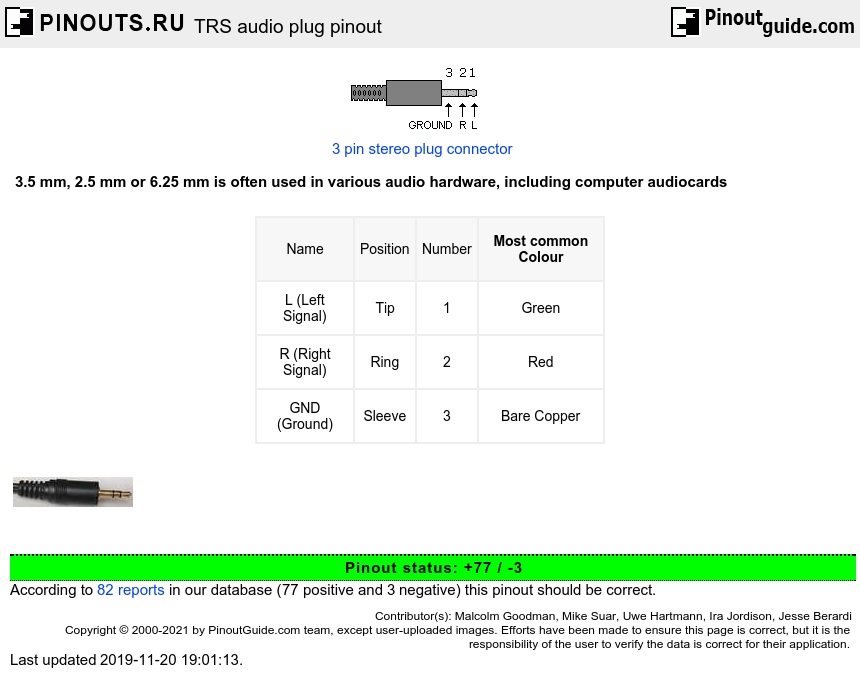A TRS connector (tip, ring, sleeve) also called an audio jack, phone jack, phone plug, jack plug, stereo plug, mini-jack, mini-stereo, or headphone jack, is a common analog audio connector. It is cylindrical in shape, typically with three contacts, although sometimes with two (a TS connector) or four (a TRRS connector).
It was invented for use in telephone switchboards in the 20th century and is still widely used, both in its original ¼″ (exactly 6.35 mm) size and in miniaturized versions: 3.5 mm (approx. 1/8″) and 2.5 mm (approx. 3/32″). The connector's name is derived from the names of three conducting parts of the plug: Tip, Ring, and Sleeve.
TRS connector typical pinout for audio plug
| Name | Position | Number | Most common Colour |
|---|---|---|---|
| L (Left Signal) | Tip | 1 | Green |
| R (Right Signal) | Ring | 2 | Red |
| GND (Ground) | Sleeve | 3 | Bare Copper |
Some common uses of jack plugs and their matching sockets are:
- Headphone and earphone jacks on a wide range of equipment. 1/4″ plugs are common on home and professional component equipment, while 3.5 mm plugs are nearly universal for portable audio equipment. 2.5 mm plugs are not as common, but are used on communication equipment such as cordless phones, mobile phones, and two-way radios.
- Consumer electronics devices such as digital cameras, camcorders, and portable DVD players
- Microphone inputs on tape and cassette recorders.
- Personal computers, sometimes using a sound card plugged into the computer. Stereo 3.5 mm jacks are used for: Line in (stereo), Line out (stereo), Headphones/loudspeaker out (stereo),Microphone input
- Electric guitars. Almost all electric guitars use a 1/4″ mono jack (socket) as their output connector.
- Instrument amplifiers for guitars, basses and similar amplified musical instruments.
- Line outputs.
- Foot switches and effects pedals.
- Effects loops, which are normally wired as patch points.
- Electronic keyboards use jacks for a similar range of uses to guitars and amplifiers, and in addition
- Sustain pedals.
- Expression pedals.
- Electronic drums use jacks to connect sensor pads to the synthesizer module or MIDI encoder. In this usage, a change in voltage on the wire indicates a drum stroke.
- Modular synthesizers commonly use monophonic cables for creating patches.
- Some small electronic devices such as audio cassette players, especially in the cheaper price brackets, use a two-conductor 3.5 mm or 2.5 mm jack as a DC power connector.
- Some photographic studio strobe lights.
- Some cameras (for example, Canon, Sigma, and Pentax DSLRs) use the 2.5 mm stereo jack for the connector for the remote shutter release (and focus activation); examples are Canon's RS-60E3 remote switch and Sigma's CR-21 wired remote control.
- Some miniaturized electronic devices use 2.5 mm or 3.5 mm jack plugs as serial port connectors for data transfer and unit programming. The second-generation iPod Shuffle from Apple has a single TRS jack which serves as headphone, USB, or power supply, depending on the connected plug.
Color codes of computer soundcard audio jacks
These codes were standardized by Microsoft and Intel in 1999 for computers as part of the PC99 standard.
| green TRS 3.5 mm | stereo output, front channels or headphones |
| gold TRS 3.5 mm | dual output, center and subwoofer |
| blue TRS 3.5 mm | stereo input, line level |
| pink TRS 3.5 mm | mono or stereo microphone input |



 correct
correct incorrect
incorrect